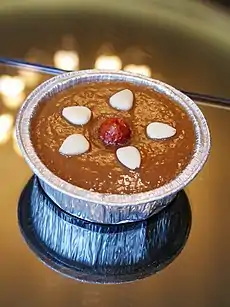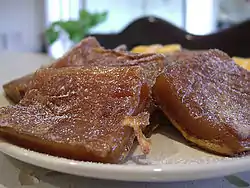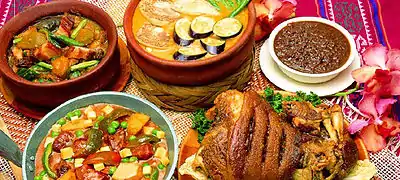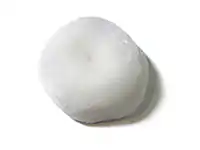Nian gao
Nian gao (also niangao; nin gou in Cantonese), sometimes translated as year cake or Chinese New Year's cake, is a food prepared from glutinous rice flour and consumed in Chinese cuisine. While it can be eaten all year round, traditionally it is most popular during the Chinese New Year. It is considered good luck to eat nian gao during this time, because nian gao is a homonym for "higher year." The Chinese word 粘 (nián), meaning "sticky", is identical in sound to 年, meaning "year", and the word 糕 (gāo), meaning "cake" is identical in sound to 高, meaning "high or tall". As such, eating nian gao has the symbolism of raising oneself taller in each coming year (年年高升 niánnián gāoshēng). It is also known as a rice cake. This sticky sweet snack was believed to be an offering to the Kitchen God, with the aim that his mouth will be stuck with the sticky cake, so that he cannot badmouth the human family in front of the Jade Emperor. It is also traditionally eaten during the Duanwu Festival.
 Cantonese-style nian gao | |
| Alternative names | Year cake, Chinese New Year's cake, tikoy, ti kuih |
|---|---|
| Place of origin | China |
| Region or state | East Asia (Mainland China, Hong Kong and Taiwan) Southeast Asia (Singapore, Malaysia, Cambodia, Indonesia, Myanmar, Philippines, Thailand and Vietnam) South Asia (Sri Lanka) |
| Variations | Varies by region (Cantonese, Shanghai, Fujian, etc.) |
| Other information | Typically consumed during Chinese New Year |
| Nian gao | |||||||||||||||
|---|---|---|---|---|---|---|---|---|---|---|---|---|---|---|---|
| Chinese | 年糕 | ||||||||||||||
| Literal meaning | year cake | ||||||||||||||
| |||||||||||||||
| Alternative Chinese name | |||||||||||||||
| Chinese | 甜粿 | ||||||||||||||
| Literal meaning | sweet kuih | ||||||||||||||
| |||||||||||||||
Originally from China, it spread to or gave rise to related rice cakes in Southeast Asian countries and Sri Lanka due to overseas Chinese influences.
Significance and rituals
Nian gao sounds identical to 年高 implying promotions or prosperity year after year. This association makes nian gao a popular gift item during the New Year period. The traditional nian gao is round with an auspicious decoration such as the character for prosperity (福) on its top. The character is often written in the traditional Chinese script.
As a gift item, nian gao are fashioned into different shapes with attractive packaging to suit the festive season. Popular designs include a pair of carps (年年有餘) symbolizing surplus every year, ingots (元寶), or the God of Wealth (財神). These designs are auspicious symbols and send good wishes for the New Year.
Production
Despite numerous varieties, they all share the same glutinous rice ingredient that is pounded or ground into a paste and, depending on the variety, may simply be molded into shape or cooked again to settle the ingredient. nian gao has many varieties including the types found in Shanghai cuisine, Fujian cuisine and Cantonese cuisine originating from Guangdong.
Types


Guangdong/Cantonese cuisine
The Guangdong variety is sweetened, usually with brown sugar. It is distinct with a dark yellow color. The paste is poured into a cake pan and steamed once more to settle mixture. The batter is steamed until it solidifies and served in thick slices. It may be eaten as is. The nian gao becomes stretchy and extremely sticky. It can also be served as a pudding flavored with rosewater or red bean paste.
The next stage is optional as it can be pan-fried afterwards, often with egg, to make fried nian gao (Chinese: 煎年糕; pinyin: jiān nián gāo; Jyutping: zin1 nin4 gou1). When fried it is slightly crispy on the outside, and remains pasty on the inside. During the Chinese New Year, it is cut into square pieces and served along with similar cake dim sum dishes like taro cake and water chestnut cake.
Fujian/Hokkien cuisine
Southern region of Fujian nian gao, natural amber, mainly for the New Year ritual and gifts. It is made of glutinous rice and taro, usually being sliced and cooked before eating. It can also be wrapped in egg or cornstarch (corn flour) or sweet potato to fry.
Jiangnan and Shanghainese cuisine
Nian gao was white along the lower reaches of the Yangtze River (the Jiangnan region) and it is a mild food. It is made by mixing rice with glutinous rice; the ratio between the two can be adjusted according to personal preferences. If you like to eat softer, you can increase the proportion of glutinous rice and vice versa. Cooking methods include steaming, frying, sliced frying or for soup. Ningbo nian gao is the most famous and common practices include pickled pork soup nian gao and shepherd's purse fried nian gao. Shanghai's ribs nian gao are also distinctive. In addition, there are more uses of the foot to make nian gao in the southern part of the rural system rice cakes, called "foot cake”. The Shanghai Niangao style is usually packaged in a thick soft rod to be sliced up or packaged pre-sliced and either stir-fried or added to soup. Depending on the cooking method this style is a soft to a chewy variant. The Shanghai style keeps the nian gao white, and made with non-glutinous rice. The color is its distinct feature. When served as a dish, the most common is the stir-fry method, hence the name (炒年糕, chǎo nián gāo). There are three general types. The first is a savory dish, common ingredients include scallions, beef, pork, cabbage, Chinese cabbage etc. The second is a sweet version using standard white sugar. The last version is taste-less, and is often consumed for its chewy textures.
Northern cuisine
Northern nian gao can be steamed or fried, mainly sweet in taste. Beijing nian gao including jujube nian gao (made with jujube and either glutinous rice or yellow rice), mince nian gao and white nian gao. Shanxi has the habit of making nian gao using fried yellow rice and red bean paste or jujube paste for filling. Hebei has the habit of using jujube, small red beans and green beans to steam nian gao. In Shandong, it is made of red dates and yellow rice. The Northeast nian gao is made of beans on sticky sorghum.
Cambodian cuisine
Buddha cake (នំព្រះពុទ្ធ) is a Cambodian counterpart to the Chinese nian gao. It is consumed during Khmer New Year.
Indonesian cuisine
In Indonesia, it is known as Kue Keranjang. Kue keranjang was originally named as Nien Kao or Ni-Kwee or Yearly Cake or Seasonal Cake, because they are only made once a year. In East Java, this cake was named Kue Keranjang because the wrapper is made from a bamboo basket with a little hole in the middle. In West Java, it was named China Cake, as the origin of the cake from China, but some call it China Cake because the producers are Chinese (known as Tionghoa).
Malaysian cuisine
In Malaysia, it is called kuih bakul (pinyin: jiān nián gāo) and is often fried in a sandwich in between pieces of taro or sweet potato.
Philippine cuisine
Nian gao is also widely consumed in the Philippines (where it is known as 'tikoy', from Hokkien 甜粿), during the Chinese New Year. It is sweetened with brown sugar, giving it a dark yellow to light brown colour, but it is also often prepared with different flavours, like ube (Purple yam), giving it a purple colour, or Pandan, giving it a green colour. Tikoy were most likely brought by the Fujianese to the Philippines, it may be eaten as is, but can also be dipped in beaten egg and lightly pan fried until crispy but still chewy inside. There is also a version of tikoy in southern Quezon province. Unlike others, this variant of tikoy is sweet and is similar to Japanese Mochi.
Sri Lankan cuisine
In Sri Lanka, seenakku (Sinhala: සීනක්කු) has a Malay origin and derives from Chinese influence.[1] Seenakku is a popular sweet among the country's Sinhalese and Malay communities and is served with grated coconut.[1] Seenakku is called cheena kueh by the Sri Lankan Malay community, with its name reflecting its Chinese origin.[2]
Vietnamese cuisine
Bánh tổ is a Vietnamese counterpart to the Chinese nian gao. It is a speciality of Quảng Nam province and also consumed by the ethnic Chinese community.
Mauritian Cuisine
In Mauritius, the nian gao is commonly called gâteau la cire (literally translated as wax cake); however, it can be written in diverse ways such as gato la cire, gato lasir, or gato lacire, etc.[3][4][5][6][7] It is a traditional cake of the Sino-Mauritian community. Traditionally, it is made with rice flour, sweetened with sugar, sometimes honey, and has orange zest as the key ingredient.[3] The classic colour of the nian gao in Mauritius has traditionally been brown; however, new colours along with new flavours, such as white (which is coconut-milk based), green (which is pandan-based), red, and yellow, has recently been introduced on the island in 2018.[3][5] In Mauritius, the nian gao is a cake which symbolized sharing;[5] it is customary for Sino-Mauritians to share and distribute nian gao to celebrate Chinese New Year to their families and friends;[7][8] and thus, nian gao is consumed by locals regardless of their ethnicity. Some nian gao found on the island is imported while others are traditionally made by the local ethnic Chinese community. The traditional way of making nian gao is still transmitted from generations to generations in some families.[9]
Combinations
Different parts of Asia have mixed the cake with different ingredients such as red bean paste or even lotus seed paste. They are not considered to be main branches or major cuisine variations.
Similar foods in East Asia
In Japan, mochi is a similar glutinous rice cake eaten primarily for the Japanese New Year.
In Korea, tteok is a similar rice cake eaten in the country. Varieties are made with glutinous rice are called chapssal-tteok (glutinous rice tteok). Tteokguk, a soup dish which uses the garae-tteok similar to the Shanghai variety of niángāo, is traditionally eaten during the Korean New Year.
References
- Hussein, Asiff (21 January 2017). "Ten Wonderful Things We Have The Malays To Thank For". roar.media. Roar. Retrieved 11 January 2018.
- Sri Lankan Malay Recipes. Galadari Hotel Colombo. p. 35. ISBN 955-8529-001.
- Rédaction, La (2019-02-02). "Fête du printemps: Le gâteau la cire en voit de toutes les couleurs". lexpress.mu (in French). Retrieved 2021-02-05.
- Edouard, Olivia (2020-01-26). "Nouvel an chinois: fête du Printemps, tout sauf ratée!". lexpress.mu (in French). Retrieved 2021-02-05.
- Grimaud, Carole (2020-01-25). "Le «gato lasir» apporte des couleurs à la Fête du Printemps". lexpress.mu (in French). Retrieved 2021-02-05.
- "Chinatown Food and Cultural Festival : vitrine de la culture sino-mauricienne". Le Defi Media Group (in French). Retrieved 2021-02-05.
- Expat News (4 February 2021). "What you need to know about Chinese New Year celebrations in Mauritius". Expat. Retrieved 5 February 2021.
- "Holidays in Mauritius - Spring Festival Mauritius". www.sunresortshotels.com. Retrieved 2021-02-05.
- Turenne, Christine (2019-02-05). "Fête du Printemps: des gâteaux intergénérationnels". lexpress.mu (in French). Retrieved 2021-02-05.

